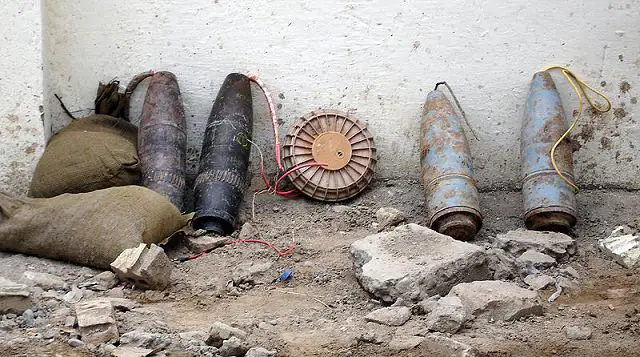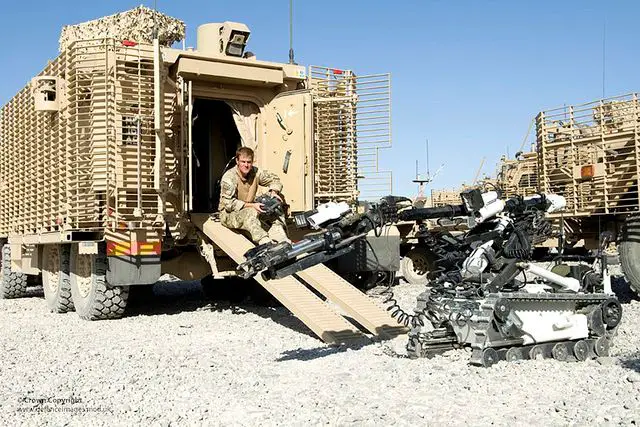Breaking news
Counter IEDs IED 2012 Conference Improvised Explosive Device daily news actualités speakers visitors.
| 2011
| a | ||||||||||||
 |
||||||||||||
6th
Annual Counter-IEDs Conference London, United Kingdom 30 - 31 May 2012 |
||||||||||||
| A Holistic Approach to Countering the Evolving Threat from IEDs | ||||||||||||
As
the dust settles after our 5th annual Counter IED conference, the DefenceIQ
team we would like to extend our thanks to all of those who took time
our of their busy schedules to participate in the event. The event featured
fascinating presentations from a diverse array of C-IED experts, whose
insights made for a highly engaging and very interesting three days. |
||||||||||||
| a | ||||||||||||
The
event will allow delegates to: |
||||||||||||
•
Hear from senior representatives within the UK MoD, US Marine Corps and
US Army about how their organisations are countering the threat from IEDs,
where their key successes have come from, and how you can apply these
lessons to your own armed forces • Gain insight into how JIEDDO funded research is identifying the key cognitive skills required for military personnel to successfully identify potential IED sites, and how these skill sets can subsequently be taught to servicemen to improve device detection rates • Learn how NATO, US and other coalition partners are successfully developing flexible TTPs for both allied and indigenous forces to improve device detection rates, IED network mapping and EOD operations |
||||||||||||
| a | ||||||||||||
| IED overview | ||||||||||||
|
|
||||||||||||
An
IED (Improvised Explosive Device), also known as a roadside bomb, is a
"homemade" device that is designed to cause death or injury
by using explosives alone or in combination with toxic chemicals, biological
toxins, or radiological material. IEDs can be produced in varying sizes,
functioning methods, containers, and delivery methods. IEDs can utilize
commercial or military explosives, homemade explosives, or military ordnance
and ordnance components. |
||||||||||||
 Iraqi Police discovered this improvised explosive device in eastern Baghdad and disarmed it before it could be detonated in a terrorist attack. The IED comprises 4 large artillery shells plus an anti-tank mine, all connected together via detonating cord. This would cause the 5 devices to detonate simultaneously. |
||||||||||||
The
enemy in Iraq has used IEDs consisting of mortar and artillery projectiles
as the explosive device. The most common explosives used are military
munitions, usually 122 mm or greater mortar/tank/artillery. |
||||||||||||
 An American armoured vehicle Cougar was hit in Al Anbar, Iraq by a directed charge IED approximately 300-500 lbs in size. All crew members survived the blast and went out the next day. |
||||||||||||
| Detection and disarmament | ||||||||||||
Since
these devices are improvised, there are no specific guidelines for explosive
ordnance disposal (EOD) personnel to use to positively identify or categorize
them. EOD personnel are trained in the rendering safe and disposal of
IEDs. The presence of chemical, biological, radiological, or nuclear (CBRN)
material in an IED requires additional precautions. As with other missions,
the EOD operator provides the area commander with an assessment of the
situation and of support needed to complete the mission. |
||||||||||||
 A British Royal Navy bomb disposal expert conducts confirmation drills during routine Counter-IED (Improvised Explosive Device) training. |
||||||||||||
Military
forces and law enforcement personnel from around the world have developed
a number of render safe procedures (RSP) to deal with IEDs. RSPs may be
developed as a result of direct experience with devices or by applied
research designed to counter the threat. The supposed effectiveness of
IED jamming systems, proven or otherwise, has caused IED technology to
essentially regress to command-wire detonation methods. These are physical
connections between the detonator and explosive device and cannot be jammed.
However, these types of IEDs are more difficult to emplace quickly, and
are more readily detected. Military forces from India, Canada, United Kingdom, Israel, Spain and the United States are at the forefront of counter-IED efforts, as all have direct experience in dealing with IEDs used against them in conflict or terrorist attacks. From the research and development side, programs such as the new Canadian Unmanned Systems Challenge, will bring students groups together to invent an unmanned device to both locate IEDs and pinpoint the insurgents. Technological countermeasures are only part of the solution in the effort to defeat IEDs; experience, training, and awareness remain key factors in combating them. For example, there are visual signs that may suggest the presence of an IED, such as recently turned-over soil or sand by a road, or an abandoned vehicle beside a road. Recognizing these telltale signs may be as valuable as having sophisticated detection equipment. |
||||||||||||
 A British soldier operates the remote controlled Mark 8 Wheel Barrow Counter IED Robot. The soldier is part of the EOD(Explosive Ordinance Device) and Search team based out of FOB (Forward Operating Base) Ouellette. |
||||||||||||
| a | ||||||||||||
| 6th Annual Counter-IEDs 2012 Official Website | ||||||||||||
| Visit the website online at Counter-IED's 2012 | ||||||||||||
| Click here fo register at IED's Conference 2012. | ||||||||||||
|
If you would like to find out further information regarding
speaking, sponsoring or marketing opportunities at the 6th Annual Counter-IEDs
event contact:
Speaking
Opportunities: |
||||||||||||
| a | ||||||||||||
| Other sources | ||||||||||||
| Annual
Counter IEDs Conference 2012 programme |
||||||||||||
|
||||||||||||
| COUNTER
IEDs 2012 News |
||||||||||||
| EOD team training can save soldiers lives against the threats of Improvised Explosive Devices IEDs. | ||||||||||||
With
millions of unexploded ordinance in and around Iraq, insurgents have the
opportunity to use them against coalition forces as IEDs (Improvised Explosive
Device) if not found and properly destroyed. On Forward Operating Base
Marez, Mosul, Iraq, the 752nd Explosive Ordinance Disposal (EOD) team
does their part by detonating stock piles so they do not fall into enemy
hands. |
||||||||||||
| Five Polish soldiers have been killed in a roadside bomb attack in esatern Afghanistan. | ||||||||||||
| NATO officials say
five Polish soldiers have been killed in a roadside bomb attack in eastern
Afghanistan, marking the deadliest single attack of the Afghan war for the
coalition member. Local Afghan officials said an improvised explosive device
went off Wednesday near the convoy of troops in Ghazni province. The Taliban
immediately claimed responsibility. |
||||||||||||
| Video
Counter IEDs Conference |
||||||||||||
| Onsite interviews conducted at 5th Annual Counter-IEDs | ||||||||||||
|
||||||||||||
|
||||||||||||
|
||||||||||||


































